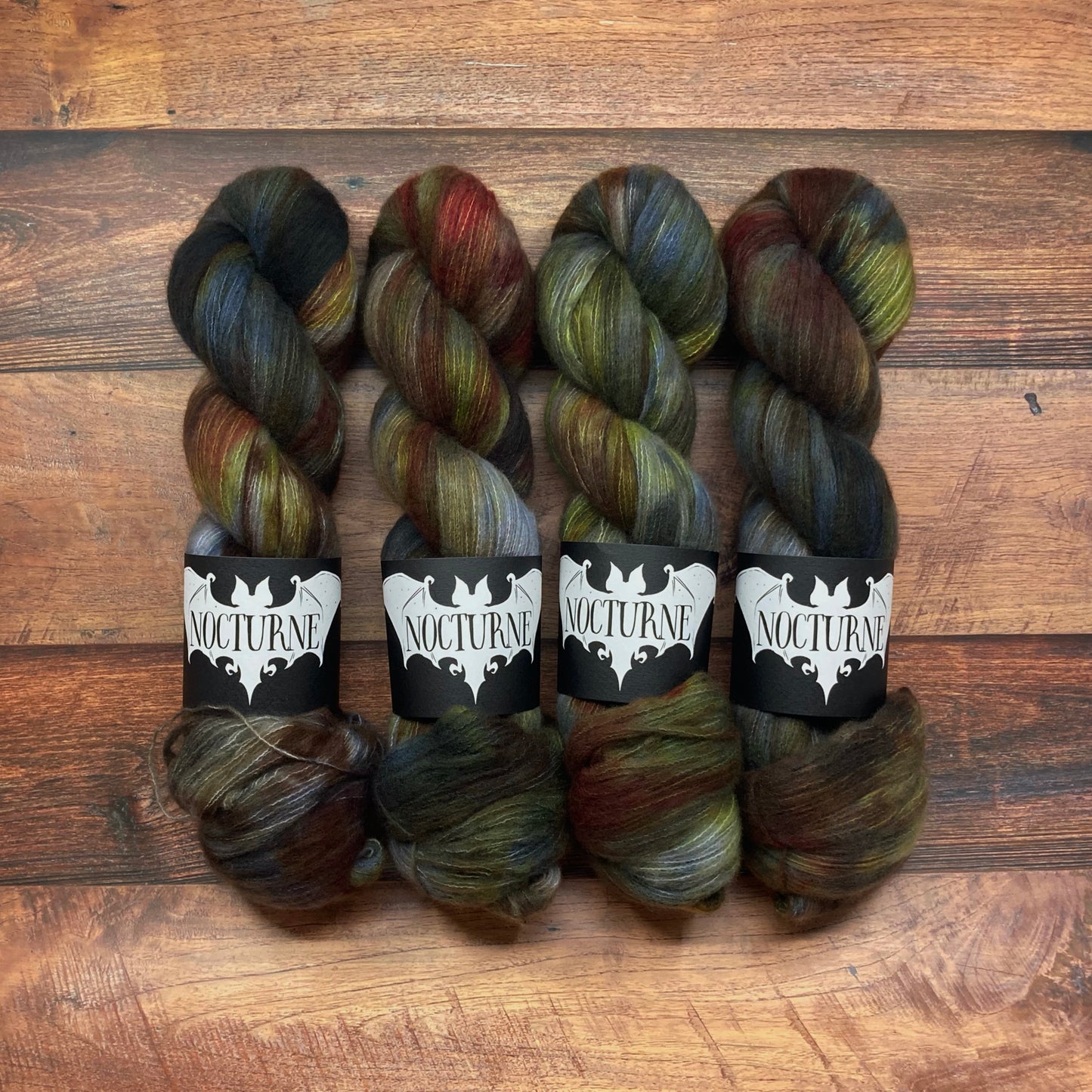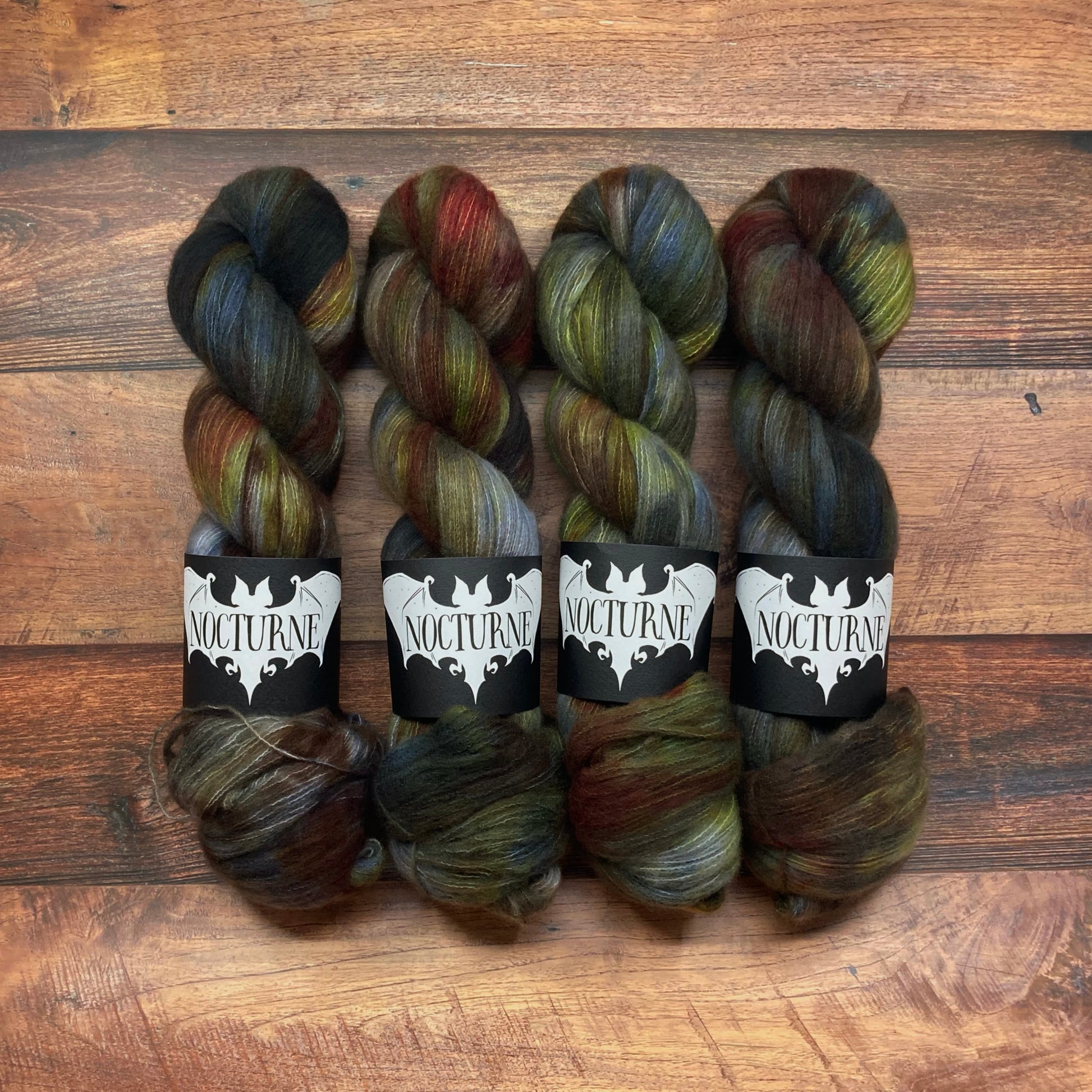Nocturne
Baba Yaga - Empyrean
Baba Yaga - Empyrean
Low stock: 1 left
- Need more? Click here for Custom Orders!
Couldn't load pickup availability
Baba Yaga is a variegated colourway with a grey base, and green, brown, and dark grey streaks.
Baba Yaga is a hag from Slavic folklore. Her character varies regionally; in some narratives, she is described as a repulsive or ferocious-looking old woman who fries and eats children, while in others, she is depicted as a kind old woman who helps the hero. She is often associated with forest wildlife. Her distinctive traits are flying around in a wooden mortar, wielding a pestle, and dwelling deep in the forest in a hut with chicken legs.
In the stories I remember from childhood, Baba Yaga takes the form of an old, repulsive woman, with gray hair, often very emaciated and sometimes with iron teeth. She throws her long, sagging breasts over her shoulder as she pursues her victim and detects the presence of a stranger thanks to her excellent sense of smell. Her relatives are usually limited to women, she is often one of three sisters, and she has daughters, who often appear in the form of mares. She does not have a husband or partner, and only rarely is it said that she has a son. He is often described as a "mangy colt" who, against all expectations, turns out to be the fastest of the herd.
She flies in a large mortar, pushing off with a pestle, and sweeping behind her with a broom. Her dwelling, although its interior does not differ from an ordinary peasant dwelling, is exceptional in that it stands "on a stilt" or "chicken legs" (or in Slovak, "magpie leg"). Her cottage can also rotate on this leg, usually at the hero's command. In other accounts, it has no windows or doors, or looks small like a coffin.
In the tale about Vasilisa the Beautiful, the house is surrounded by a fence made of bones and skulls with shining eye sockets. Yaga's dwelling is also very far from human dwellings, for example, behind a fiery river, a deep abyss, on the shore of a large sea, in the middle of a swamp or underground. However, it is most often located on the edge or in the depths of a dark and difficult-to-pass forest, this is typically understood as the Nav: the Slavic underworld.
The image of Baba Yaga in fairy tales and legends is usually negative. She is a cannibal with an immense appetite who likes to eat children. She usually has a full pantry in her home, and she can be seen sharpening her large teeth, or chasing a victim with her mouth wide open, and trying to catch them with her long tongue. She usually chases people who have wandered into her territory, stolen some valuable object from her, or goes hunting on her own accord.
However, in many stories, her role is not only negative. A common motif is when a hero, or a heroine, comes to her with a request for advice or help. In these tales, the protagonist often visits three Baba-sisters, each of whom is older and wiser than the previous one.
Empyrean
Fiber contents: 68% Non-superwash Merino (16,5 micron), 22% Silk, 10% Cashmere
Weight per skein: 50 g / 1,7 oz
Running length Fingering: 420 m / 459 yds
Yarn Weights Available: Lace
Empyrean is a deliciously soft, fluffy lace-weight yarn base, perfect as an alternative to mohair or suri alpaca. It is excellent as a complementary thread to be held with a different yarn, or just by itself, and it is also wonderful to be used for adding subtle colour accents to your fabric.
I chose the name Empyrean for its incredible, divine softness.
In ancient European cosmologies inspired by Aristotle, the Empyrean heaven, Empyreal or simply the Empyrean, was the place in the highest heaven which was supposed to be occupied by the element of fire (or aether in Aristotle's natural philosophy). In medieval Christianity, the Empyrean was the third heaven and beyond "the heaven of the air and the heaven of the stars."
Empyrean can also mean "heavenly" or "celestial".
Share

Collapsible content
Essential Information for buying our Hand-Dyed Yarns
When purchasing hand-dyed yarn, we recommend buying enough for your entire project.
Our yarn is handmade in small batches. While we follow precise recipes for repeatable colorways and carefully measure our materials, slight variations between skeins are inevitable. No two skeins will ever be identical, as is the nature of handcrafted products.
We take new photos for each dye lot, so images on our website may differ from skeins you’ve purchased in previous batches.
For a more uniform appearance in knitting, crochet, or weaving, alternate skeins every few rows.
We ensure all dyes are fully exhausted before rinsing our yarn. However, mild color bleeding can still occur, especially with bright, dark, or speckled skeins. To prevent unexpected color transfer, rinse your skein in cold water with wool wash and let it dry before starting your project.
For detailed care instructions, please follow this link.
This listing is for one (1) skein of yarn unless stated otherwise. Photos of multiple skeins are for comparison purposes, showcasing differences between yarn bases and/or skeins.
Please note that colorways may appear slightly different due to display settings on your device. Especially keep this in mind if you are using apple devices, which are known to alter colours. While we optimize our photography for color accuracy, viewing images on a monitor provides the most reliable representation.
